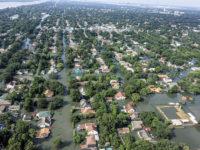More than two months after Hurricane Sandy, Nicole Chati and her neighbors stood in front of a sad collection of aid tents in a beachfront park tangled with downed trees on Staten Island, trying to make rebuilding plans. A 12-foot-high storm surge had crushed some houses and flooded others up to their eaves. Asked how the 40-year-old homemaker and her neighbors were faring, Chati said at the time, “We’ve gotten no protection, so we flooded again at Christmas. We have to juggle insurance, FEMA, charities, contractors. It’s really stressful.”
The predictable chaos and lack of information are the outcome of any disaster, but one year after Sandy (which killed 150 people and damaged or destroyed some 650,000 houses), officials, charities, and disaster experts are concluding that much can be done to smooth the recovery process—and that there’s more for architects to do other than drive-by damage assessments and holding empty “ideas” competitions. Now architects are working in neighborhoods to link people like Chati to the resources they need.
Sandy was a much more destructive storm than predicted, and so-called 100-year storms may now arrive much more frequently. Such unprecedented climate violence makes the option of simply rebuilding questionable. Architects must not only assist in raising buildings and strengthening roofs, they are also thinking about how to prepare vulnerable communities for tough future decisions—including moving people away from areas that can’t be protected.
Homeowners don’t necessarily know what to do. In the past, the nonprofit Architecture for Humanity has prepared disaster libraries, with rebuilding guidance organized by building system. For one week in October, the organization cohosted the Sandy Design Help Desk.
The City of New York began long-range planning just months after the storm. Officials used a process called the Special Initiative for Rebuilding and Resilience to figure out what kind of community protections—like higher bulkheads or heftier dunes—should be built along public shorelines. Once that was known, owners would have a clearer picture of how high to rebuild and how sturdy the construction needed to be. Released in June, the Initiative’s expedited plan, “A Stronger, More Resilient New York,” strikingly rejected such massive civil-engineering silver bullets as a barrier gate extending for miles from Sandy Hook in New Jersey to Coney Island in Brooklyn. Instead it recommended diverse architectural and landscape strategies, like wave-deflecting dunes, water-storing wetlands, and armatures to permit the quick installation of flood walls during emergencies. Tailored to neighborhood conditions, these tactics—some now in design—are more readily implemented and less costly than civil-engineering works.
New York City’s report homed in quickly on natural-system solutions because the groundwork had already been laid by PlaNYC, a 2007 growth plan that substantially focused on climate change. “It was a really brilliant initiative that is the backbone of making resilience possible,” says Susannah Drake, principal of the landscape architecture firm Dlandstudio. Rising Currents, a 2010 exhibition at New York’s Museum of Modern Art of plans and designs for coping with the encroaching ocean, also proved enormously influential. Appointed by Barry Bergdoll, then the museum’s chief curator of architecture, Drake collaborated with Architecture Research Office (ARO) in proposing rebuilt marshes and “sponge parks” to minimize flood damage. Ideas from all the teams with work in the exhibition have come to prominence in the Sandy response.
Architects and related professionals are also refining broad planning ideas to suit specific neighborhood conditions where coastal residents may fear solutions that obliterate the pleasurable experiences of the past. (In New Jersey, some beachfront owners went to court to stop the building of protective dunes that blocked views of the ocean. They lost.) Some things went smoothly. By last Memorial Day, seven months after Sandy, New York City’s debris-strewn beaches had been cleaned up in time for the summer season. Visitors returning to the Rockaway beaches in Queens found restored concession stands surrounded by fabric-topped trellises in wave forms by Sage and Coombe Architects, who worked with the landscape architect Signe Nielsen. Prefabricated lifeguard stations by Garrison Architects perched as high as 20 feet above the beach, in anticipation of possible flood levels.
Restored boardwalks must coexist with dunes as high as the lifeguard stations. Walter Meyer and Jennifer Bolstad, of Local Office Landscape Architecture, have designed dunes sculpted to bounce waves back to sea, with patches of trees and shrubs to diffuse high winds. Working with architects at WXY Studio, they propose a public path of hardened cementitious sand that will meander among the hillocks of ordinary sand. As bucolic as this sounds, it’s a much larger and less familiar beach intrusion than a classic boardwalk, and Meyer and Bolstad recognize that community approval may not come easily.
Meanwhile, a presidential task force, partnering with private funders like the Rockefeller Foundation, has begun Rebuild by Design, intended to identify innovative rebuilding strategies. Ten interdisciplinary teams totaling 180 professionals are developing “a set of projects and opportunities that can build comprehensive solutions” by next March, says Henk Ovink, senior advisor to the task force.
Recovery is a years-long process, which has led people to explore how to take ad hoc groups that arise out of desperate need and turn them into long-term recovery groups (LTRGs) that can plan for a daunting future. FEMA has begun to codify what it has learned from past disasters to help neighborhood groups that sprang up post-Sandy become more robust organizations, engaged in long-term planning.
Nicole Chati’s neighbors banded together to form the Yellow Boots Long Term Recovery Group. According to Tina Marquardt, who has advised them as executive director of the New Orleans–based Beacon for Hope, they are now mapping the condition of about 2,300 households to see which still need rebuilding help or other aid. In a more ad hoc manner, architect Deborah Gans has been working in Brooklyn’s Sheepshead Bay, apart from FEMA-sanctioned groups, to help raise a neighborhood of bungalows to include shared decks above parking, while fixing a storm-drainage system that invites floods.
Balancing the need for speed and deliberative planning isn’t easy. “The approach here has been, rebuild bigger, better, faster, but there’s a real danger to that,” says Tim McCorry, an architect who lives and works in the hard-hit town of Belmar, New Jersey. Indeed, a fire that roared through blocks of just-rebuilt boardwalk businesses in Seaside Park, New Jersey, on September 12 was blamed on wires corroded in the storm and overlooked during rebuilding. The most delicate conversations concern whether to rebuild at all in vulnerable locations. Moving communities out of harm’s way is called “managed retreat”: it is emotionally wrenching and rarely implemented. But rising seas and more violent weather may make retreat a large-scale necessity. It cannot succeed until government aligns monetary, regulatory, and land-use incentives (such as the transfer of development rights) to offer owners a way to recover at least some of the value they give up. “Architects have to lead conversations that are sensitive but say, ‘Let’s not build in flood zones,’ ” says McCorry. “And if we build near the ocean, to consider how can we do it in as resilient a way as possible.”








